Hermes
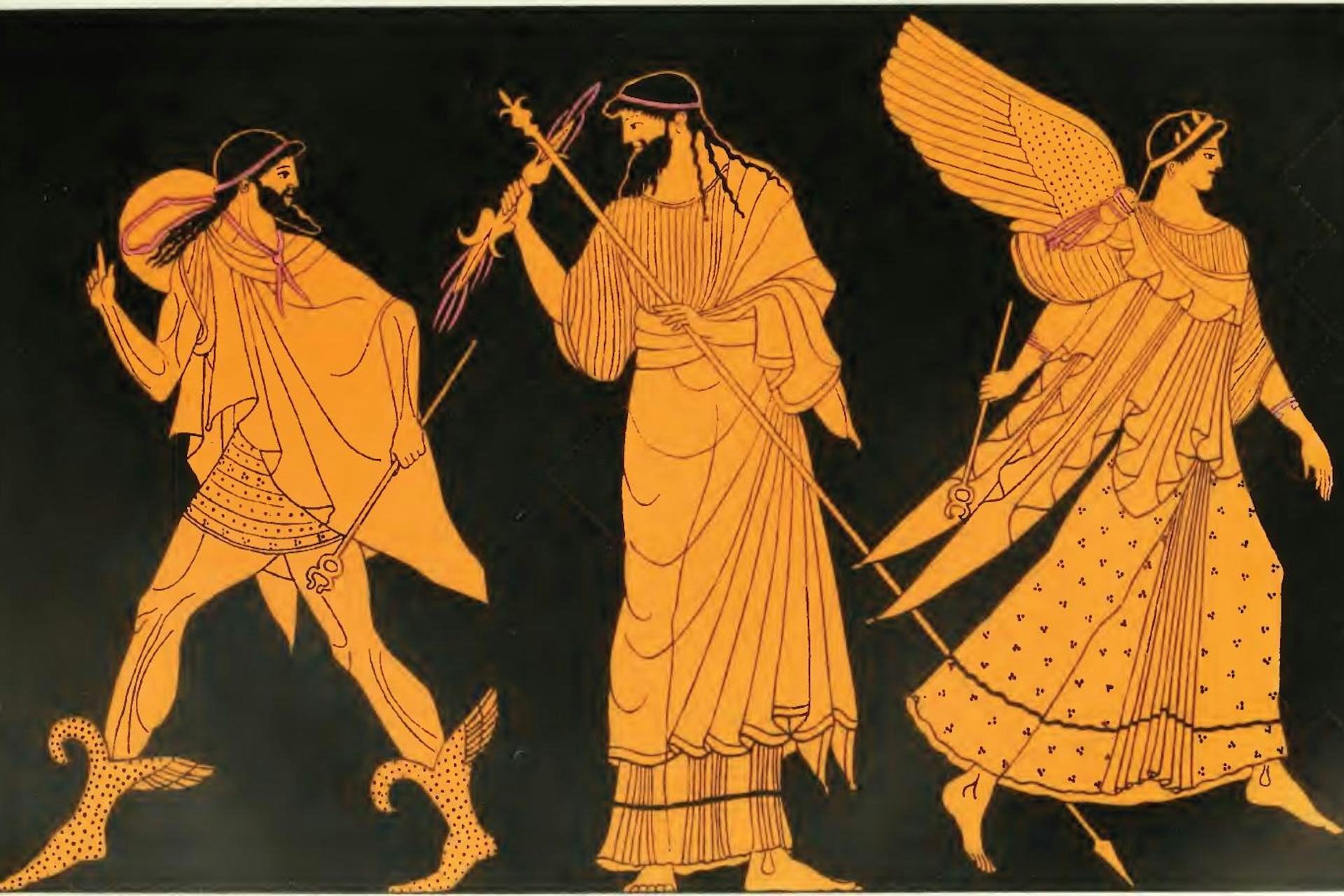
Attic red-figure stamnos attributed to the Berlin Painter (ca. 480–470 BCE) showing Zeus (center) sending out Iris (right) and Hermes (left), now in the Louvre Museum. Illustration by François Lenormant.
Gazette archéologique (1875)Public DomainOverview
Hermes was one of the Twelve Olympians and the god who watched over messengers and heralds. He was also connected with travelers, thieves, shepherds, and mystery cults. It was Hermes who conveyed the souls of the dead to the Underworld.
As herald and messenger of the gods, Hermes delivered the news, advice, and commands that maintained order and sustained the gods’ fragile relationships. In myth, he was usually presented as a mischievous but benign figure—an intermediary between mortals and the gods who ruled them.
Key Facts
What were Hermes’ attributes?
Hermes was usually represented as a beardless youth wearing a cap and winged sandals. He sometimes carried additional attributes, such as his special snake-entwined staff—the caduceus.
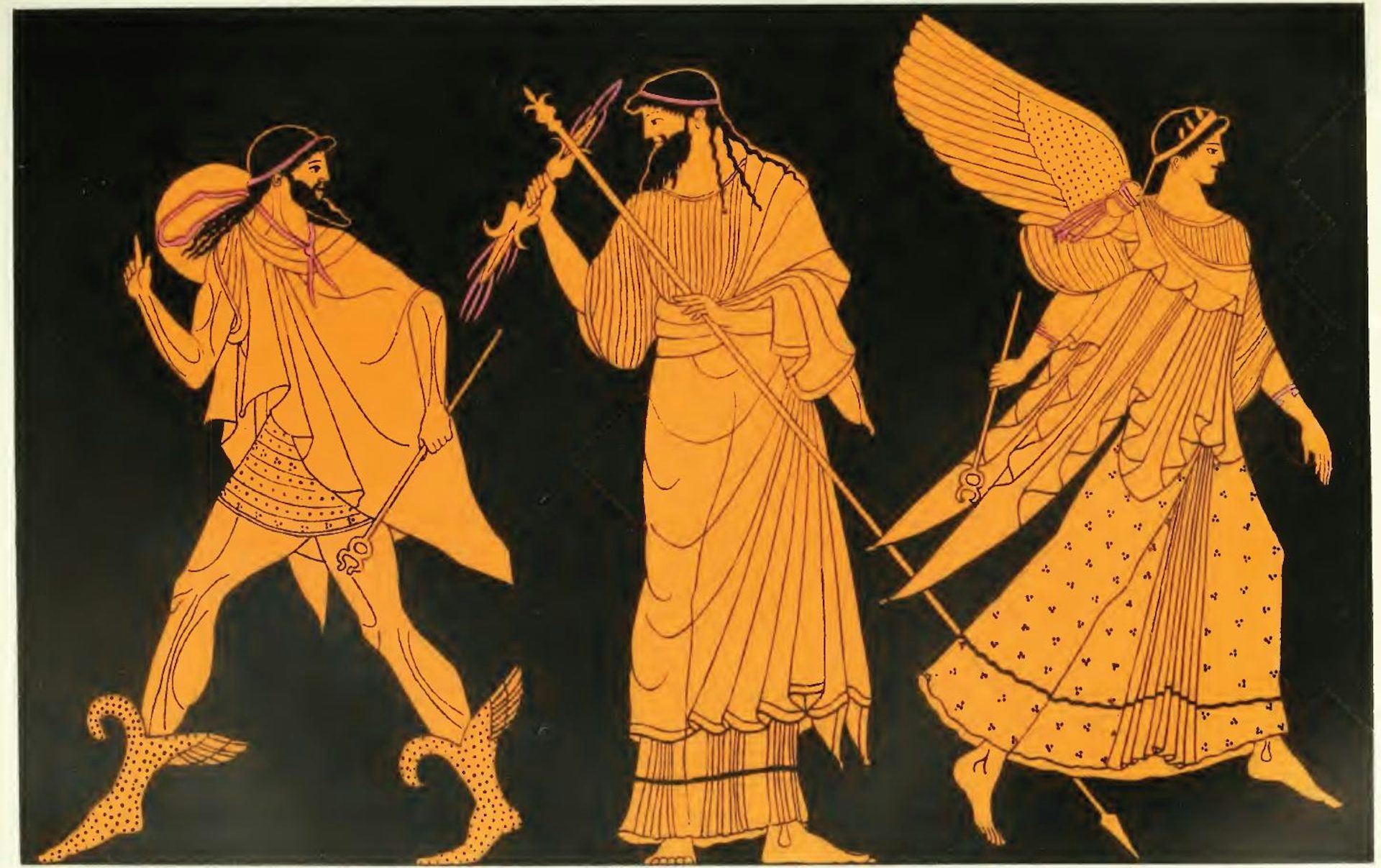
Attic red-figure stamnos attributed to the Berlin Painter (ca. 480–470 BCE) showing Zeus (center) sending out Iris (right) and Hermes (left), now in the Louvre Museum. Illustration by François Lenormant.
Gazette archéologique (1875)Public DomainWho were Hermes’ parents?
Hermes was the son of Zeus, the supreme god of the Greek pantheon, and Maia, a daughter of Atlas. In most accounts, Maia bore and raised Hermes on Mount Cyllene, in the region of Arcadia.
Hermes’ mischievousness was evident from the start; in one myth, while he was still an infant, he managed to steal the cattle of his elder half-brother Apollo. Eventually Hermes ascended to Olympus, where he became the messenger of the gods.
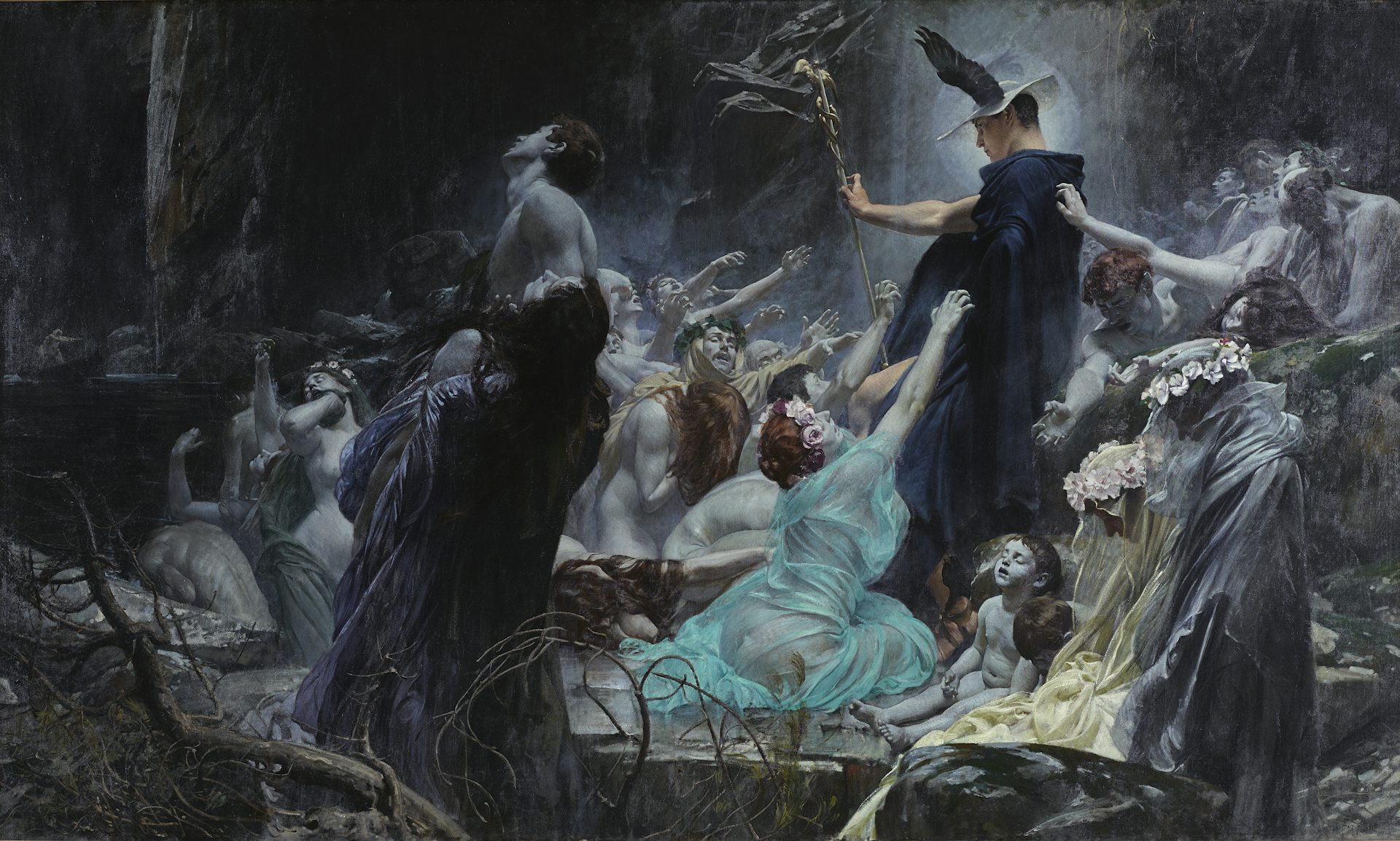
Souls on the Banks of the Acheron by Adolf Hirémy-Hirschl (1898)
Belvedere (Austria)Public DomainHermes Slays Argus Panoptes
In one well-known myth, Zeus sent Hermes to free his lover Io from the clutches of Argus Panoptes—a monster whose defining quality was his many unsleeping eyes. Zeus’ jealous wife Hera had placed Io under the custody of the ever-watchful Argus to prevent Zeus from sleeping with the girl.
In the familiar version of the myth, Hermes cleverly lulled Argus to sleep with soothing music. When the last of Argus’ many eyes had finally shut, he killed the monster and set Io free.
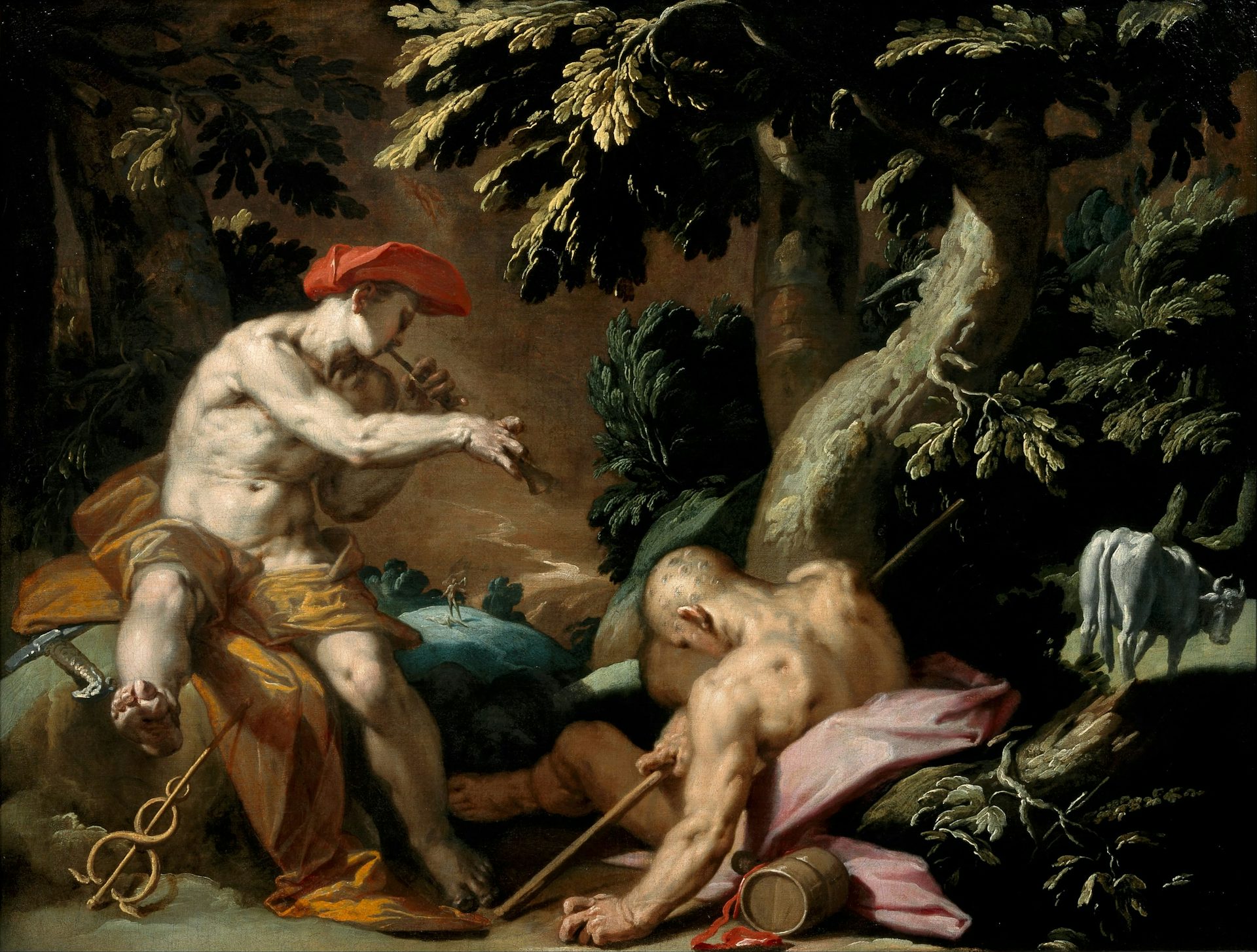
Mercury, Argus and Io by Abraham Bloemaert (ca. 1592).
Centraal MuseumPublic DomainEtymology
The name “Hermes” seems to have originated in the Mycenaean period, the earliest period of Greek history (ca. 1600–1100 BCE). It was first written as e-ma-ha in the syllabic Linear B script used before the invention of the Greek alphabet.
Hermes’ name may have been related to the ancient Greek herma, a cairn or heap of stones used to indicate the boundaries of something. Indeed, many of these “herms” were dedicated to Hermes. But it is not clear where the word herma comes from or how exactly it is linguistically related to the name “Hermes.” Scholars today generally agree that Hermes’ name is pre-Greek in origin.[1]
Pronunciation
English
Greek
Hermes Ἑρμῆς Phonetic
IPA
[HUR-meez] /ˈhɜr miz/
Other Names
Epithets
Hermes’ most common literary epithet was Argeiphontēs, meaning “killer of Argus.” This related to the famous myth in which Hermes outsmarted and killed the hundred-eyed guardsman Argus (see below). Other important epithets related to Hermes’ mythology included Atlantiadēs, meaning “descendant of Atlas” (Hermes’ mother, Maia, was the daughter of the Titan Atlas), and Cyllēnios, meaning “Cyllenian” or “of Mount Cyllene” (Mount Cyllene was an important cult center of Hermes, sometimes said to have been his birthplace).
Other epithets described important attributes of Hermes. These included dolios (“tricky”), angelos and diactoros (“messenger”), eriounios (either “swift” or “beneficial”—the meaning is uncertain), and chrysorrhapis (“he of the golden wand”).
Finally, Hermes boasted numerous religious and cult epithets that described his many functions as a god. Among these were hodios (“he of the road”), oneiropompos (“conductor of dreams”), poimandrēs (“shepherd of men”), agoraios (“he of the market”), and psychopompos (“conductor of souls”).
Attributes
Domains
As a god, Hermes was primarily associated with four domains: (1) messengers and heralds; (2) boundaries, travel, and commerce; (3) shepherds; and (4) the mysteries. In these capacities, Hermes presided over many areas of human life.
As the messenger of the gods, Hermes broadly represented communication and was invoked as the patron and protector of heralds and diplomats.
Hermes’ association with boundaries was also very broad: he was the god not only of travelers but also of merchants, thieves, and even the passage from life to death (it was Hermes who led the souls of those who died to the Underworld).
Hermes was also a pastoral god, seen as the protector of shepherds and livestock. Indeed, in his iconography Hermes was sometimes portrayed with a ram slung over his shoulder to represent his role as god of shepherds.
Finally, Hermes was associated with the enigmatic mystery cults of the ancient world, which tended to promise a privileged afterlife attainable through initiation and ritual. Hermes was often regarded as the god who presided over these mysteries.
Iconography and Symbols
Hermes’ representation in art and literature was quite distinctive. He was usually shown wearing a chiton (a short tunic), a chlamys (a short robe), and a petasos (a broad-brimmed sun hat). He could also be easily identified by his winged sandals and the kērykeion (better known by its Latin name, caduceus), a herald’s staff or wand wrapped by two intertwined snakes.
In early Greek art, Hermes was shown as either bearded or beardless. But from the fifth century BCE on, he was almost always boyish and clean-shaven.
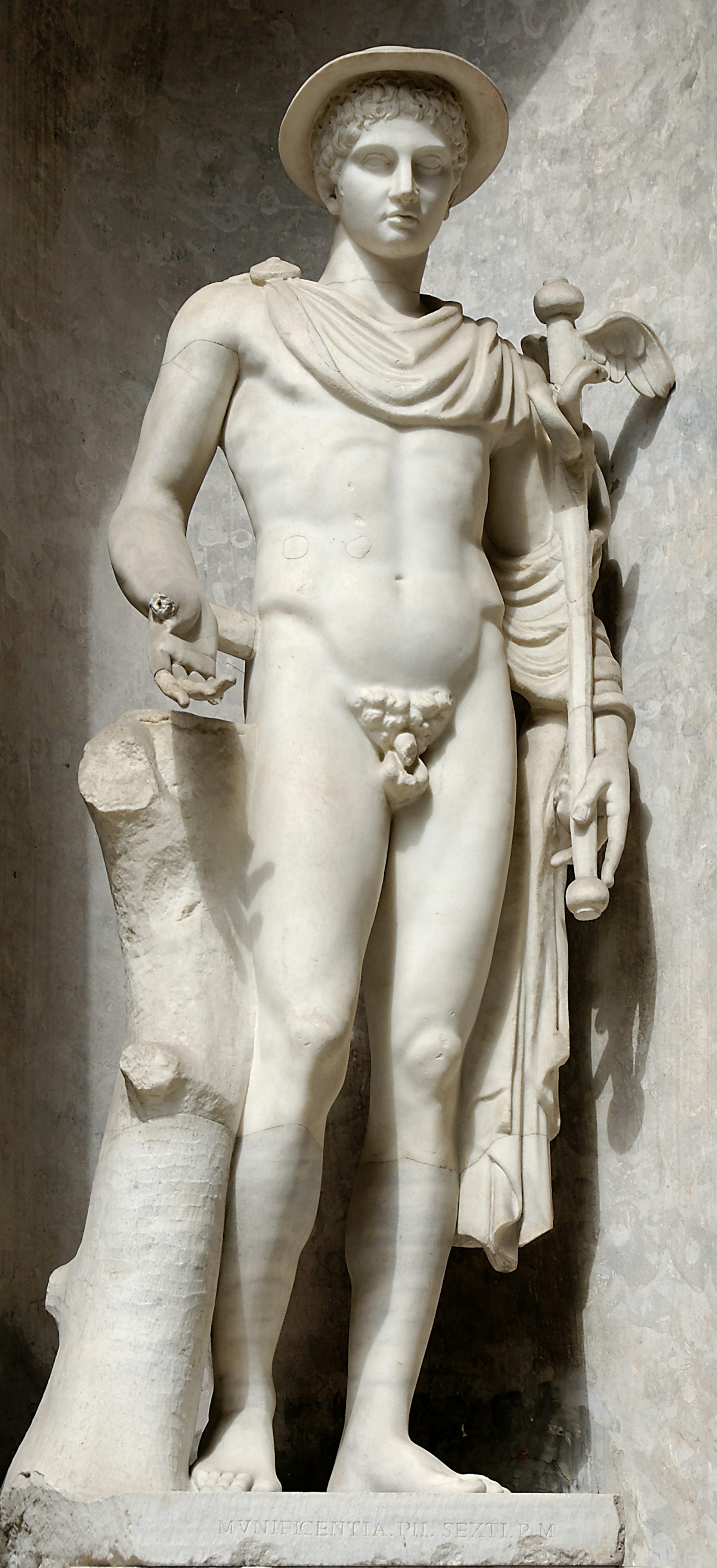
Hermes Ingenui, 2nd century BCE copy of 5th century BCE Greek original. Vatican Museums, Rome. As is common in depictions of the god, Hermes appears as a very young man without a beard (he was the second youngest of the Olympians). He is shown equipped with his customary winged temples, his herald’s staff (the caduceus), a musical instrument called a cithara, a round hat, and a traveler’s cloak.
Marie-Lan Nguyen / Wikimedia CommonsPublic DomainPossibly the most distinctive object in Hermes’ iconography was the herm, a semi-anthropomorphic stone pillar used as a boundary marker throughout ancient Greece. Herms were often topped by a bust identified as Hermes; the middle of the pillar featured a phallus, perhaps representing Hermes’ association with fertility.
Hermes was known as something of a loner and did not have a grand entourage like many of the other Olympians. He was, however, sometimes seen in the company of the animals deemed sacred to him, which included the rooster, the dog, the goat, and the ram.
Family
Family Tree
Mythology
Origins
Hermes was usually said to have been born in secret, in a dark cave on the slopes of Mount Cyllene in the Peloponnese (around the region of Arcadia).[5] His mother, Maia, one of the daughters of the Titan Atlas, had retreated there in an attempt to avoid contact with the gods. Zeus found her despite her best efforts and began a sexual relationship that culminated with the conception of Hermes. According to the Homeric Hymn to Hermes:
Muse, sing of Hermes, the son of Zeus and Maia, lord of Cyllene and Arcadia rich in flocks, the luck-bringing messenger of the immortals whom Maia bare, the rich-tressed nymph, when she was joined in love with Zeus,—a shy goddess, for she avoided the company of the blessed gods, and lived within a deep, shady cave. There the son of Cronos used to lie with the rich-tressed nymph, unseen by deathless gods and mortal men, at dead of night while sweet sleep should hold white-armed Hera fast. And when the purpose of great Zeus was fixed in heaven, she was delivered and a notable thing was come to pass. For then she bare a son, of many shifts, blandly cunning, a robber, a cattle driver, a bringer of dreams, a watcher by night, a thief at the gates, one who was soon to show forth wonderful deeds among the deathless gods.[6]
The Theft of Apollo’s Cattle
Growing faster than his mother could have anticipated, the young god child crept from his mother’s embrace and crawled away on the first night after his birth. As he ventured forth into the darkness, Hermes found a turtle, scraped the meat from its shell, and set reeds and animal sinews into it. In so doing, he created the first lyre, an instrument forever associated with ancient Greek culture.
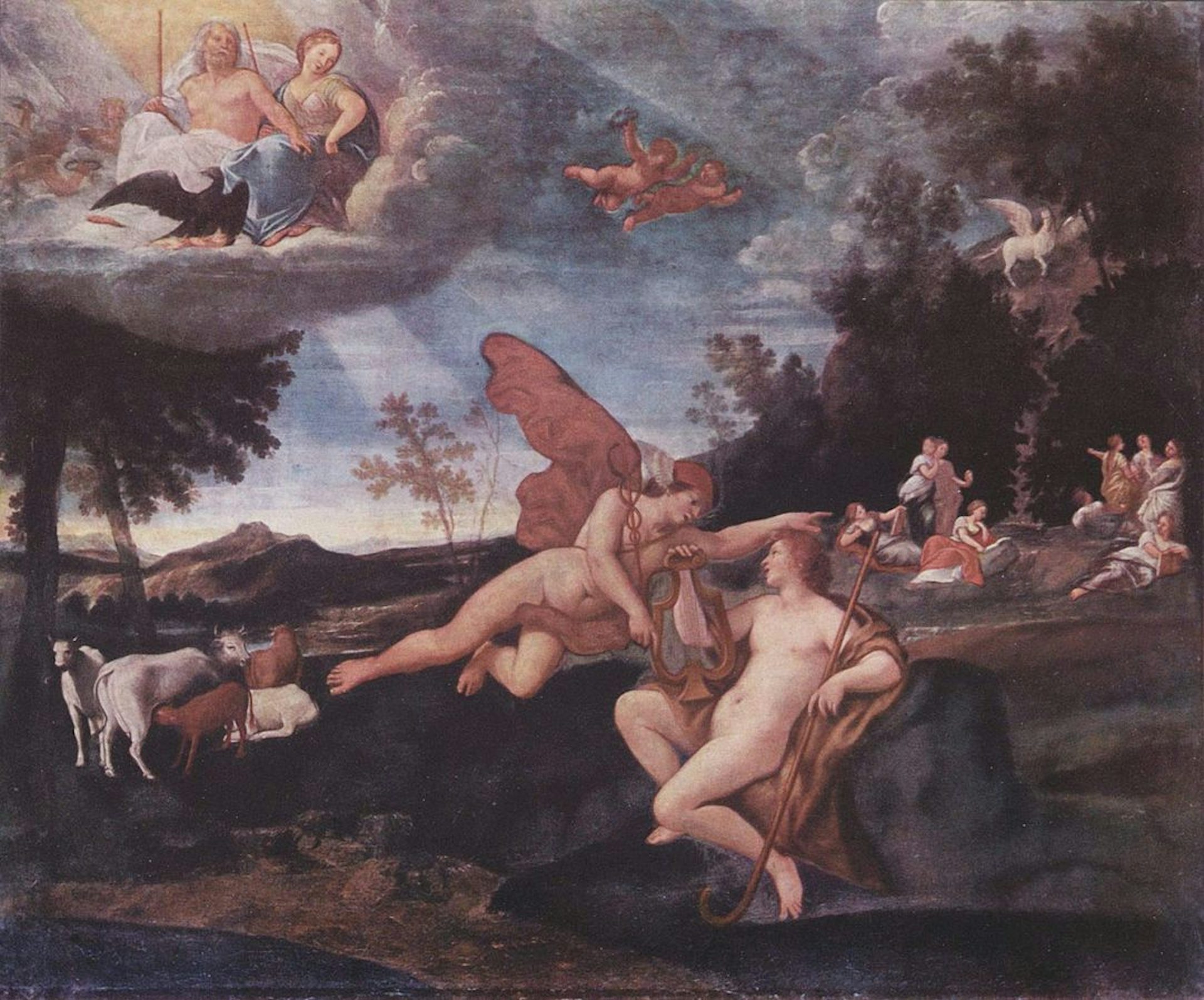
Hermes and Apollo by Francesco Albani (1623–1625).
Wikimedia CommonsPublic DomainHermes’ next stop was the pastures of Thessaly, where his half-brother Apollo kept his herds of cattle. In an early showcase of the mischievous behavior that would come to define him, Hermes made off with the cattle. When Apollo discovered the theft and tracked Hermes down, the newborn god tried to play the part of an innocent baby. But Apollo was not fooled.
When Hermes continued to deny his crime, Apollo appealed to Zeus, who often arbitrated feuds among the gods. Finding Hermes guilty, Zeus ordered the young god to return the cattle. Cornered, Hermes offered Apollo his lyre instead, an offer his half-brother eagerly accepted. So it was that Apollo first took up the lyre, the instrument he would use to become the greatest of all musicians.
The Killing of Argus
Hermes always accomplished his heroic deeds with wit and guile—never brute strength. One famous myth featured Hermes rescuing Zeus’ lover Io from the vengeful designs of Hera and the watchful gaze of Argus.
Zeus had fallen for Io, a young, mortal priestess of Hera, and in his lust came down from Olympus to ravish her. When Hera found out about the affair, she set out to find and punish Io. To obscure any evidence of his infidelity, Zeus transformed his young lover into a heifer and hid her among a herd of cattle. Hera discovered the ploy and ordered Argus, a giant with many eyes, to watch the herd until Io revealed herself.
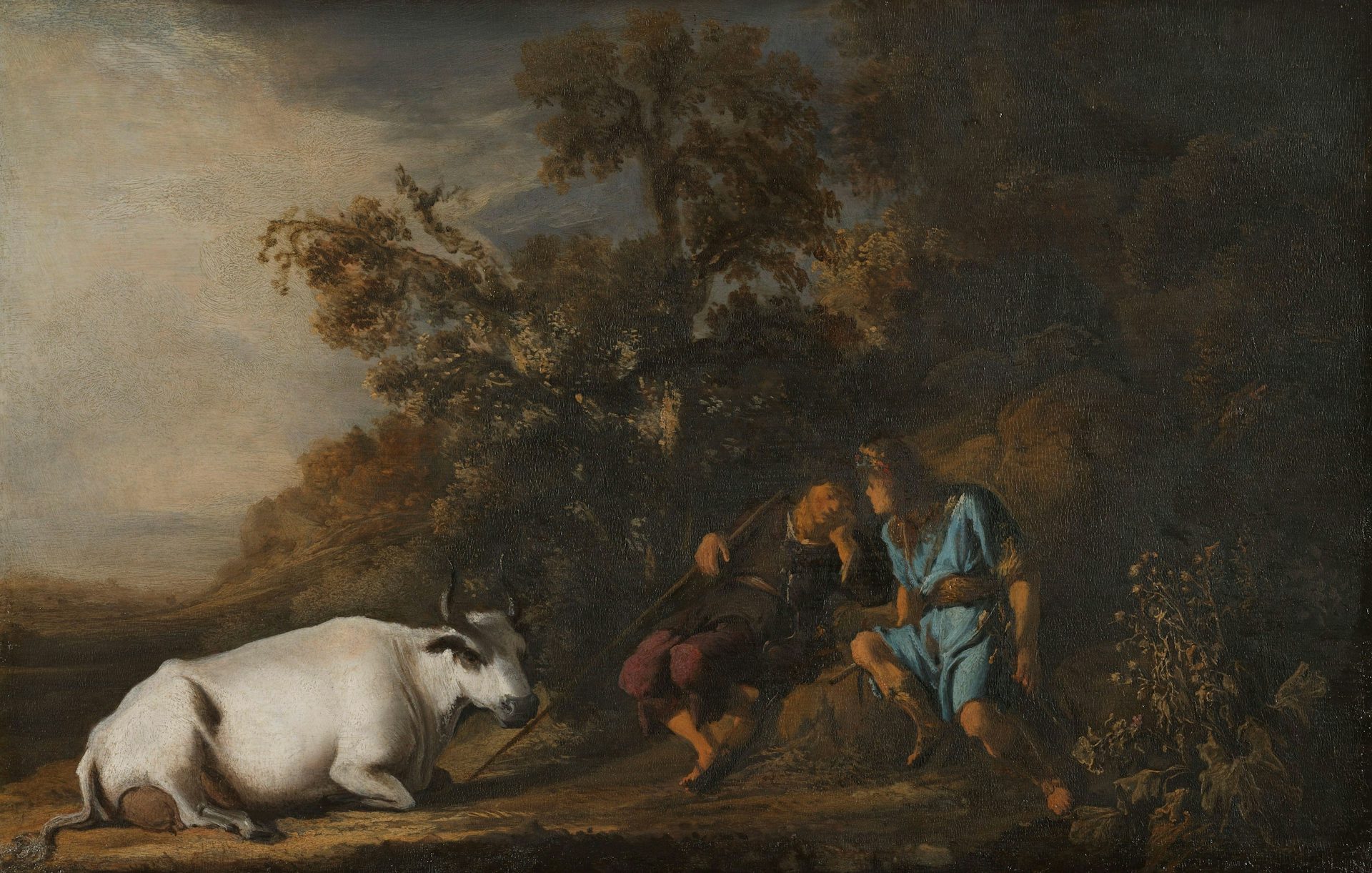
Mercury, Argus and Io by Govert Flinck (1635–1645).
RijksmuseumPublic DomainOn the verge of being bested, Zeus appealed to Hermes for assistance. Flying into action, Hermes distracted Argus, in most versions by lulling him to sleep. When the all-seeing giant finally closed all of his eyes in slumber, Hermes killed him with either a stone or a sword (there are different versions).[7] The adventure resulted in Hermes earning the title “Argeiphontes,” meaning “killer of Argus,” an epithet that would come to be closely associated with the god.
Hermes and the Olympians
The most roguish of all gods and goddesses, Hermes was a master of whispers and a teller of lies. His status among the other Olympian gods was a complex one: though one of the Twelve Olympians himself, Hermes was also the messenger of the gods, representing communication between the powerful, remote gods and the mortals whose lives were often at their mercy.
Hermes did not have a wife; more than almost any other god, he stood out as a loner, often more at home in the rough world of scrappy mortals than in the unchanging blissfulness of Olympus. By comparison, even Hephaestus, the gruff cripple, was married (albeit to the unfaithful Aphrodite).
However, Hermes certainly pulled his weight among both gods and mortals. When the Giants attacked Mount Olympus, Hermes fought alongside the other gods and goddesses, killing a Giant named Hippolytus.[8] Some stories also credit Hermes as an inventor of fire: it was Hermes who discovered how to kindle a flame using friction by rubbing sticks together.[9] In other stories, Hermes lent a helping hand to various heroes, including Perseus and Heracles.
Not all of Hermes’ actions were benevolent, however. According to Hesiod, when all of the gods imbued Pandora with their special “gifts,” Hermes contributed speech and deception. This ensured that Pandora would open “Pandora’s box” and unleash all known evils upon the world of humans.[10]
Hermes in Homer
As the chief herald and messenger of the gods and goddesses, Hermes wielded the enormous power of information. Nowhere was this faculty better exemplified than in the Homeric epics, the Iliad and the Odyssey.
In the Iliad, Hermes was among the gods who generally backed the Greeks in their fight against the Trojans. His role in the conflict was largely unremarkable, save for an episode in which he guided King Priam of Troy to the body of his son Hector, helping him to safely retrieve it from the violent and dangerous Achilles.[11]
Hermes also had a role in the Odyssey, where he used the full measure of his cleverness to deliver Odysseus, his great-grandson, back into the loving embrace of his wife and son. Hermes first visited Odysseus on the island of Aeaea, where the hero of the Trojan War was being detained by Circe, an enchantress and mischief-maker who had turned Odysseus’ crewmen into pigs. Hermes informed Odysseus of Circe’s treachery and gave him a magical herb called moly that protected him from the sorceress’s charms. Thanks to this valuable exchange, Odysseus was able to force Circe to restore his men to human form.[12]
Later in his travels, Odysseus again found himself detained, this time by the beautiful nymph Calypso on the island of Ogygia. Hermes came to his aid once more, this time delivering news from Zeus himself. The king of Olympus had ordered Calypso to release Odysseus so that he could continue on his journey home. Seeing she had no choice in the matter, Calypso relented and released Odysseus and his crew.[13]
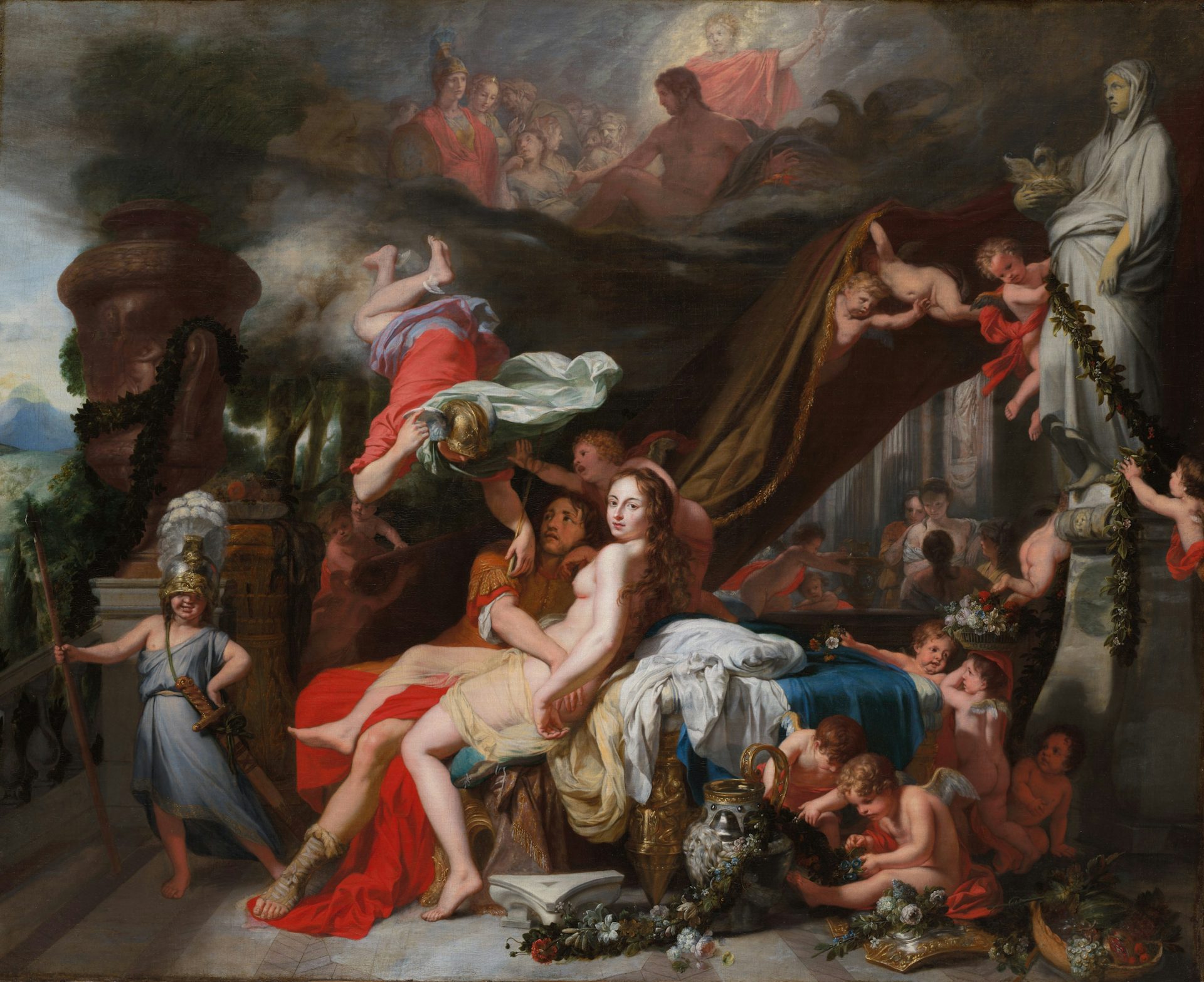
Hermes Ordering Calypso to Release Odysseus by Gerard de Lairesse (ca. 1670).
Cleveland Museum of ArtCC0When Odysseus finally returned home to Ithaca, he killed the opportunistic suitors who—by seeking Penelope’s hand in marriage—had sought to usurp Odysseus’ role as patriarch of his family. Fittingly, it was Hermes who conveyed their unworthy souls to the Underworld.[14]
Worship
Festivals
Festivals of Hermes were usually called Hermaia and were often Saturnalia-esque: that is, societal roles were temporarily reversed during the festival. For example, the island of Samos had a festival of Hermes Charidotes during which everybody was permitted to steal.[15] On Crete, there was a different festival of Hermes in which masters waited on their slaves.[16]
Temples
Hermes’ most important centers of worship were on Mount Cyllene in Arcadia, where he was usually said to have been born. According to myth, the ancient temple of Hermes on Mount Cyllene was actually built by Lycaon, one of the first kings of Arcadia, who was transformed into a wolf for his hubris.[17]
Hermes also had temples and sanctuaries in other major cities, such as Athens, Sparta, and Thebes.
Finally, Hermes’ most widespread sanctified spaces were the herms: semi-anthropomorphic stone pillars adorned with a bust and phallus that were set up along roads, houses, and buildings throughout ancient Greece.
A famous historical event illustrates how seriously the Greeks took the herms. In 415 BCE, many of the herms in and around Athens were mysteriously vandalized in the middle of the night. Numerous high-profile suspects were arrested, and one suspect, the general Alcibiades, actually went into exile to avoid a trial and possible execution. Alcibiades ended up defecting to Sparta, with whom the Athenians were fighting at the time. Thus, the religious fears and superstitions of the Greeks ended up influencing interstate politics.[18]
Pop Culture
Hermes was not the most popular of gods due to his ambiguous reputation; nevertheless, he and his famous accoutrements often appear in popular culture.
Hermes can be found in most modern depictions of Greek mythology, though these contemporary characters don’t always align with his reputation in antiquity. In Disney’s Hercules (1997), he is depicted as a geeky, bespectacled messenger who avoids confrontation. In the film version of the Rick Riordan novel Percy Jackson and the Sea of Monsters, Hermes is again presented as a messenger (or more specifically, as an executive of a package delivery company)—quirky and unpredictable, though ultimately well-meaning.
The feathers of Hermes’ winged sandals often appear in advertisements and logos as a symbol of swiftness and reliability. Goodyear, for example, has used this symbol to sell its tires. Likewise, the logo of the FTD flower delivery company features an image of Hermes rushing by with flowers in his hand—shorthand for the swiftness and reliability of its delivery services. Hermes has also been used in the logos of many national mail services.

The insignia of the United States Public Health Service includes a caduceus, a winged rod with a pair of snakes coiled around it famously carried by Hermes. The USPHS is a division of the United States Department of Health and Human Services.
US National Library of MedicinePublic DomainPerhaps most famously of all, Hermes’ staff, the caduceus (a winged rod with a pair of snakes coiled around it), has been used as a general symbol for medicine and the chief symbol of the American Medical Association.